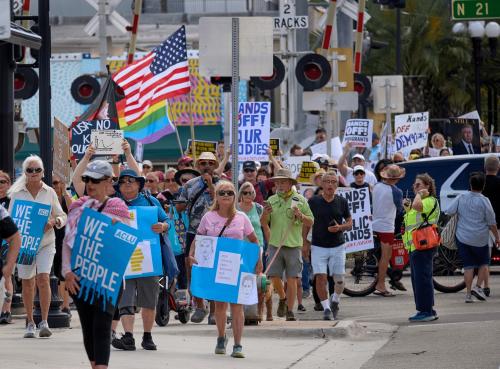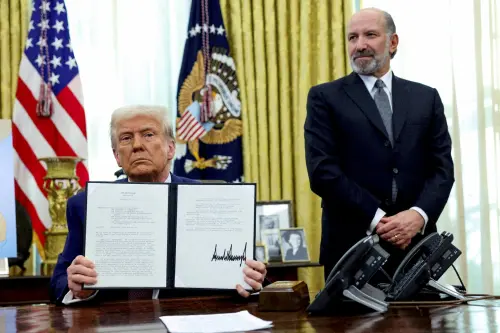In the court of public opinion, the verdict on Donald Trump’s first three months has been mostly negative, especially on his handling of the economy, and his overall job approval has declined significantly.
Trump began his second term with a burst of public goodwill and hope. After his first week, an average of 50.5% of the American people approved of the way he was doing his job, while 44.3% disapproved, a net positive rating of 6.2 percentage points, according to the RealClearPolitics polling average. By mid-April, his job approval had fallen to 46.9%, a decline of 3.6 points, while disapproval rose to 50.3%, an increase of 6.0 points. This represents a substantial swing of 9.6 points, from a net positive of 6.2 points in late January to a net negative of 3.4 points today.
Trends within the highly regarded Economist/YouGov survey, which is conducted weekly, help us understand why this is happening. According to this survey, the public’s top concerns since the beginning of the administration until now have been economic, specifically inflation/high prices and jobs/overall economy. Back in January, Trump’s handling of inflation and high prices was viewed positively by 45% of the public and negatively by 39%, for a net positive rating of 6 points. But by mid-April, the public’s assessment had become strongly negative, with just 37% approving versus 55% disapproving. Approval fell by 8 points, while disapproval surged by 16 points. Trump’s handling of jobs and the economy during this period showed another concerning pattern, beginning with a 12-point net positive rating and ending with a 7-point negative. Approval fell by 7 points while disapproval rose by 12 points.
Not surprisingly, the public’s confidence in their economic future took a hit. At the beginning of the administration, 38% expected that “a year from now, you and your household will be better off,” compared to just 20% who expected to be worse off. By April, the share who expected to be better off had fallen by 7 points to 31% while the share who expected to be worse off had increased by 14 points to 34%. Otherwise put, an 18-point net positive turned into a 3-point negative.
Donald Trump’s victory over Kamala Harris in the 2024 presidential election reflected large gains among two previously Democratic-leaning groups, Hispanics and young adults ages 18 to 29. Since the beginning of his administration, however, his loss of support from these groups has been especially steep. Among Hispanics, his favorability has fallen from 42% to 25% while disapproval has rocketed from 47% to 71%. Among young adults, his rating moved from a 5-point net positive (48% to 43%) to a 21-point net negative (33% to 54%). During this period, Hispanic approval of his handling of inflation and high prices dropped sharply—from 42% approving and 37% disapproving to 27% approving and 67% disapproving—a net decline of 45 points. Among young adults, approval also fell significantly, with a net drop of 40 points. Consistent with these economic judgments, the share of both Hispanics and young adults who thought that the country was on the wrong track rose by 10 points.
There is, of course, no guarantee that these trends will continue, but Trump’s decision to impose high tariffs on the rest of the world may make it more difficult for him to recover the ground he has lost, and his shifting stances on when and where to implement these tariffs further weakens public support as well as business confidence.
The most recent Economist/YouGov survey found only 38% approval for this strategy, compared to 54% disapproval. Only 30% of young adults approved, and among Hispanics, just 24%, with 67% disapproving. Fifty-one percent of young adults and 60% of Hispanics believe that these tariffs will be harmful to both the economy and consumers, with “no real long-term benefits.”
It’s not hard to see why. Fully 75% of Americans—and similar shares of Hispanics and young adults—believe that Trump’s tariffs will increase prices for what they buy, while only 6% think that these tariffs will lower prices. The president has not persuaded Americans that foreign countries and producers will bear the burden of higher tariffs, or that the gain will be worth the pain.
The significance of the survey findings extends beyond the administration’s current travails. In the wake of the 2024 elections, many observers suggested that Donald Trump’s strong showing among Hispanics and young adults indicated a long-term realignment away from the Democratic Party toward the Republicans. But if their current economic disappointment leads them to reconsider their choice, they are more likely to become swing groups in the electorate than parts of the base of either party, and the pattern of closely contested elections yielding narrow and shifting majorities could continue indefinitely.
The Brookings Institution is committed to quality, independence, and impact.
We are supported by a diverse array of funders. In line with our values and policies, each Brookings publication represents the sole views of its author(s).






Commentary
Trump loses public support during his first 3 months in office
April 18, 2025